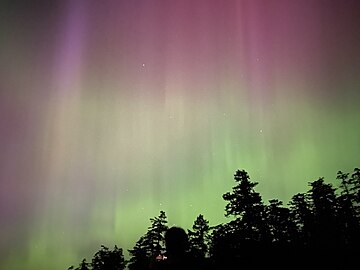May 2024 solar storms: Difference between revisions
RodRabelo7 (talk | contribs) mNo edit summary |
m MORE images from MORE countries than USA & UK. Tags: Reverted Visual edit Disambiguation links added |
||
| Line 41: | Line 41: | ||
|File:AuroraBorealisOkeford20240510-01.jpg|Aurora as seen from [[Okeford Hill]], [[Dorset]], UK |
|File:AuroraBorealisOkeford20240510-01.jpg|Aurora as seen from [[Okeford Hill]], [[Dorset]], UK |
||
|File:Bay View, WA auroras.jpg|Aurora as seen from [[Bay View, Washington]] |
|File:Bay View, WA auroras.jpg|Aurora as seen from [[Bay View, Washington]] |
||
|File:20240510 230827 Aurora Borealis (May 10 2024 solar storms) as seen from Kraków 14.jpg|Aurora as seen from [[Kraków]], Poland |
|||
|File:Aurora in Czechia1.jpg|Aurora as seen from [[Most]], Czechia |
|||
<!-- |
<!-- |
||
Revision as of 13:54, 11 May 2024
This article is about a current solar storm where information can change quickly or be unreliable. The latest page updates may not reflect the most up-to-date information. Please refer to your local weather service or media outlets for the latest weather information pertaining to a specific location. |
 | |
| Date | May 2024 |
|---|---|
| Type | Coronal mass ejection |
| Part of Solar cycle 25 | |
The solar storms of May 2024 are an ongoing powerful series of solar storms with intense to extreme solar flare and geomagnetic storm components ongoing since 10 May 2024, during solar cycle 25.[1][2] The storm produced aurorae at far lower latitudes than usual in both northern and southern hemispheres.[3]
Solar flare
On 8 May 2024, very active region 3664 produced many near X-class or X-class flares, causing several coronal mass ejections (CMEs) to launch in earth's direction. The region next day produced another powerful X-class flares (X2.25 and X1.12) associated with two full-halo CMEs.The region produced X3.98 flare the next day and on 11 May it produced X5.89 flare with another asymmetrical full-halo CME. The region also caused S1 solar radiation storm with spikes to S2.
The eruption of an additional X5.4 magnitude solar flare was reported 11 May 2024 at 01:23 UTC.[4]
Geomagnetic storm

Three CMEs from 8 May reached earth on 10 May 17Z, causing severe to extreme geomagnetic storm with bright and very long-lasting aurorae. Aurorae could be seen from Europe immediately after sunset even in Croatia. In America the aurora was seen even from Florida. In southern hemisphere the aurora was seen in New Zealand, Australia, Chile and Argentina. Interplanetary magnetic field reached 73 nT and Bz was oriented strongly south, reaching -50 nT, along with somewhat high density and elevated solar wind speed reaching 750-800 km/s, this was the reason to rate the storm G5, making it most intense storm since the 2003 Halloween solar storms. Several other CMEs are expected to reach on May 11 and 12.
Comparison to other solar storms
The disturbance storm time index is a measure in the context of space weather. A negative Dst value means that Earth's magnetic field is weakened. This is particularly the case during solar storms. The May 1921 geomagnetic storm had estimates of intensity of Dst = −907±132 nT. While estimates for the Carrington Event superstorm of 1859 are between −800 nT and −1750 nT.[5]
Currently, the highest negative measurement for the May 2024 solar storms is −412 nT.[6]
Gallery
Aurorae
-
Aurora as seen from Osage Beach, Missouri
-
Aurora as seen from Pawleys Island, South Carolina
-
Aurora as seen from East Sussex, UK
-
Aurora as seen from Okeford Hill, Dorset, UK
-
Aurora as seen from Bay View, Washington
-
Aurora as seen from Kraków, Poland
-
Aurora as seen from Most, Czechia
See also
Notes
References
- ^ Miller, Katrina; Jones, Judson (10 May 2024). "Solar Storm Intensifies, Filling Skies With Northern Lights - Officials warned of potential blackouts or interference with navigation and communication systems this weekend, as well as auroras as far south as Southern California or Texas". The New York Times. Archived from the original on 11 May 2024. Retrieved 11 May 2024.
- ^ Fritz, Angela; Hammond, Elise; Lau, Chris (10 May 2024). "Live updates: The latest on the massive solar storm". CNN. Archived from the original on 11 May 2024. Retrieved 11 May 2024.
- ^ Ralls, Eric (10 May 2024). "Auroras expected all weekend across the U.S. as massive solar storm hits Earth". Earth.com. Archived from the original on 11 May 2024. Retrieved 11 May 2024.
- ^ "Yet Another X-class Flare!". Space Weather Prediction Center. National Oceanic and Atmospheric Administration. 11 May 2024. Archived from the original on 11 May 2024. Retrieved 11 May 2024.
- ^ "Near Miss: The Solar Superstorm of July 2012 - NASA Science". science.nasa.gov. Archived from the original on 11 May 2024. Retrieved 11 May 2024.
- ^ "Real-time Dst Index". World Data Center for Geomagnetism, Kyoto. Archived from the original on 10 May 2024. Retrieved 11 May 2024.







